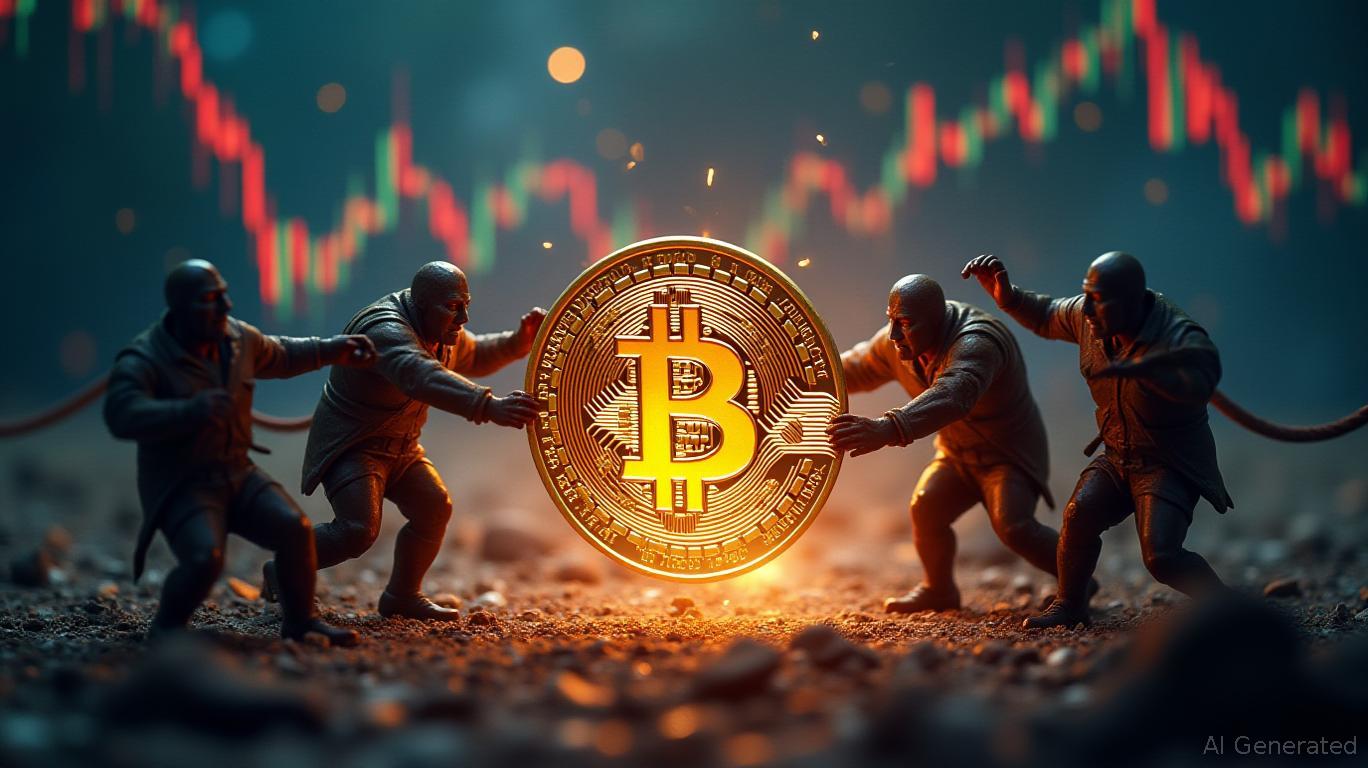Macroeconomic Push and Pull Limits Bitcoin’s Uptrend Even as Risk Appetite Grows
- Bitcoin remains capped below $110,000 despite gold/equity gains, constrained by macroeconomic factors like global liquidity, ISM Manufacturing Index, and U.S.-China tensions. - Raoul Pal argues extended liquidity cycles and delayed ISM peaks (vs. 2020-2021) prolong Bitcoin's bull run into 2026, with TGA liquidity drains and debt maturity shifts key drivers. - U.S.-China trade tensions triggered 3-8% altcoin corrections, yet institutional holders increased BTC holdings, contrasting subdued retail particip

Despite recent advances in gold and stock markets, Bitcoin’s value has struggled to break above $110,000, reigniting discussions about what’s holding back its growth. Experts highlight several macroeconomic factors at play, such as shifts in global liquidity, the Institute for Supply Management (ISM) Manufacturing Index, and ongoing U.S.-China geopolitical tensions. Raoul Pal, Real Vision’s co-founder and a prominent macro analyst, believes this current Bitcoin bull run differs fundamentally from previous cycles, with liquidity trends potentially pushing the market’s peak out to 2026
Pal’s perspective centers on the relationship between worldwide liquidity and the ISM index, which tracks U.S. manufacturing health. He observes that Bitcoin’s price has historically moved in sync with the ISM, especially during periods of economic growth. However, with the ISM still below 50—a sign of contraction—Bitcoin’s potential for gains remains limited. Pal attributes this to a lengthened business cycle, where debt maturities have shifted from four to five years, postponing the liquidity and risk-taking peak Raoul Pal, “Bitcoin Market Cycle Extended to 5 Years,” *The Crypto Basic* [ 2 ]. This stands in contrast to the 2020–2021 period, when both liquidity and the ISM peaked together, resulting in a shorter bull run Raoul Pal and Julien Bittel, “Liquidity Wave Extends Crypto Bull Run Into 2026,” *NewsBTC* [ 1 ].
Liquidity trends add further complexity. Since mid-July, the U.S. Treasury General Account (TGA) has rebuilt rapidly, pulling about $500 billion out of the system and reducing liquidity Raoul Pal and Julien Bittel, “Liquidity Wave Extends Crypto Bull Run Into 2026,” *NewsBTC* [ 1 ]. This external drain has hit risk assets like Bitcoin particularly hard, as they depend on favorable macro conditions. At the same time, the People’s Bank of China (PBoC) has injected $33 billion into global markets, partially counteracting the U.S. tightening. These differing monetary approaches have created a mixed backdrop for crypto, with institutional players weighing U.S. rate hikes against China’s more cautious easing.
The trade relationship between the U.S. and China is also a significant factor. Recent developments, such as the U.S. reimposing tariffs and stalled talks, have led to a 3–8% drop in altcoins and a 3.9% decline in Bitcoin from its record high. Still, institutional investors remain optimistic. Major Bitcoin holders (wallets with 1,000–10,000 BTC) have increased their positions, showing confidence even amid economic uncertainty. In contrast, retail involvement is low, with less than 20% of Unspent Transaction Outputs (UTXOs) held by short-term traders—far below the 50% seen at previous market peaks.
Bitcoin’s connection to the stock market has also grown stronger. According to the CME Group, since 2020, Bitcoin’s correlation with the S&P 500 and Nasdaq-100 has moved from neutral to a positive 0.5 Justin Sun and PBoC Analysis, “Liquidity Injections and Crypto Markets,” *CoinEdition* [ 6 ]. This shift highlights increased institutional adoption and integration into portfolios, with Bitcoin now often seen as an extension of equity risk rather than a separate hedge. If global liquidity and the ISM index continue to rise, analysts like Pal suggest Bitcoin could surpass $300,000, provided these favorable trends persist CME Group, “Bitcoin’s Evolving Relationship with Equities,” *OpenMarkets* [ 4 ]. However, this outlook depends on the ISM climbing to between 56 and 65, a milestone that may still be months away CME Group, “Bitcoin’s Evolving Relationship with Equities,” *OpenMarkets* [ 4 ].
The future remains unpredictable. While liquidity boosts and a weaker dollar are supportive for crypto, risks from geopolitics and TGA-driven liquidity drains could keep volatility elevated. Pal stresses the need for patience, advising investors to avoid leverage and to align their investment timelines with broader economic cycles CME Group, “Bitcoin’s Evolving Relationship with Equities,” *OpenMarkets* [ 4 ]. With the U.S. Federal Reserve facing the challenge of refinancing $9 trillion in debt over the next year, the interplay between monetary policy and crypto liquidity is likely to shape Bitcoin’s direction in the months ahead Raoul Pal and Julien Bittel, “Liquidity Wave Extends Crypto Bull Run Into 2026,” *NewsBTC* [ 1 ].
Disclaimer: The content of this article solely reflects the author's opinion and does not represent the platform in any capacity. This article is not intended to serve as a reference for making investment decisions.
You may also like
Vitalik Buterin's Latest Support for ZK Technology and What It Means for the Cryptocurrency Industry
- Vitalik Buterin is driving a blockchain shift via ZK tech, enhancing Ethereum's scalability and privacy. - ZK infrastructure's $28B TVL surge highlights projects like zkSync Era and StarkNet boosting DeFi and gaming. - Investors target EVM-compatible ZK rollups and privacy toolkits, aligning with Ethereum's ZK roadmap.

XRP News Today: IMF Cautions That Tokenized Markets Could Face Collapse Without International Cooperation
- IMF warns tokenized markets risk destabilizing flash crashes due to rapid growth and interconnected smart contracts. - XRP highlighted as potential cross-border payment solution but not endorsed, alongside Stellar and Bitcoin-Lightning hybrid models. - Global regulators intensify oversight of tokenized assets, with ESMA, SEC, and central banks addressing governance and liquidity risks. - IMF stresses urgent need for coordinated policy frameworks to prevent fragmentation and systemic vulnerabilities in ev

Solana News Today: Avail's Nexus Mainnet: A Borderless Blockchain Ecosystem
- Avail launches Nexus Mainnet, a cross-chain infrastructure unifying liquidity across Ethereum , Solana , and EVM-compatible chains. - The platform uses intent-solver architecture and Avail DA verification to replace bridges, enabling seamless asset movement and shared liquidity. - Integrations with major chains and partners like Lens Protocol aim to streamline DeFi and trading, while $AVAIL token coordinates cross-chain transactions. - With Infinity Blocks targeting 10 GB blocks, Nexus addresses liquidit

Cardano News Today: ETFs Turn to Alternative Coins While ADA Stumbles and XLM Gains Momentum with ISO Compliance
- Franklin ETF expands holdings to include ADA , XLM, XRP , and others, reflecting institutional altcoin diversification driven by ISO 20022 compliance and SEC-approved rules. - Cardano faces short-term bearish pressure with 31% monthly decline, contrasting Stellar's bullish 2025/2030 price projections ($1.29–$6.19) fueled by RWA and cross-border payment demand. - ISO 20022 adoption (97% payment instructions) positions ADA/XLM as bridges between DeFi and traditional finance, with Ripple's ILP enhancing XLM